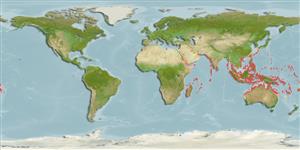Teleostei (teleosts) >
Eupercaria/misc (Various families in series Eupercaria) >
Scaridae (Parrotfishes) > Scarinae
Etymology: Scarus: Greek, skaros = a fish described by anciente writers as a parrot fish; 1601 (Ref. 45335).
More on author: Valenciennes.
Environment: milieu / climate zone / depth range / distribution range
Ecology
Marine; reef-associated; depth range 1 - 20 m (Ref. 9710). Tropical
Western Indian Ocean: East Africa south to Natal, South Africa; also around islands of the western Indian Ocean.
Size / Weight / Age
Maturity: Lm ? range ? - ? cm
Max length : 37.0 cm TL male/unsexed; (Ref. 5490); max. published weight: 900.00 g (Ref. 3488)
Inhabits shallow lagoon reefs, in areas with dense coral cover (Ref. 9710). Individuals in the initial phase form groups (Ref. 9710). Feeds on algae by incessant grazing in coral reefs (Ref. 5503). Marked sexual dimorphism.
Life cycle and mating behavior
Maturity | Reproduction | Spawning | Eggs | Fecundity | Larvae
Oviparous, distinct pairing during breeding (Ref. 205).
Randall, J.E., 1986. Scaridae. p. 706-714. In M.M. Smith and P.C. Heemstra (eds.) Smiths' sea fishes. Springer-Verlag, Berlin. (Ref. 5490)
IUCN Red List Status (Ref. 130435)
Threat to humans
Harmless
Human uses
Fisheries: commercial
More information
ReferencesAquacultureAquaculture profileStrainsGeneticsElectrophoresesHeritabilityDiseasesProcessingNutrientsMass conversion
Tools
Special reports
Download XML
Internet sources
Estimates based on models
Preferred temperature (Ref.
123201): 25 - 29.3, mean 28.5 °C (based on 3197 cells).
Phylogenetic diversity index (Ref.
82804): PD
50 = 0.5000 [Uniqueness, from 0.5 = low to 2.0 = high].
Bayesian length-weight: a=0.01380 (0.00764 - 0.02493), b=3.00 (2.85 - 3.15), in cm total length, based on LWR estimates for this species & Genus-body shape (Ref.
93245).
Trophic level (Ref.
69278): 2.0 ±0.00 se; based on food items.
Generation time: 1.3 ( na - na) years. Estimated as median ln(3)/K based on 1
growth studies.
Resilience (Ref.
120179): High, minimum population doubling time less than 15 months (K=0.8).
Fishing Vulnerability (Ref.
59153): Low vulnerability (20 of 100).
Nutrients (Ref.
124155): Calcium = 48.5 [31.5, 81.7] mg/100g; Iron = 0.874 [0.615, 1.341] mg/100g; Protein = 18.7 [16.6, 20.5] %; Omega3 = 0.0881 [, ] g/100g; Selenium = 19.6 [12.3, 30.4] μg/100g; VitaminA = 39.2 [12.0, 133.8] μg/100g; Zinc = 2.35 [1.78, 3.06] mg/100g (wet weight);
